Find all of our dahlia resources all in one place!
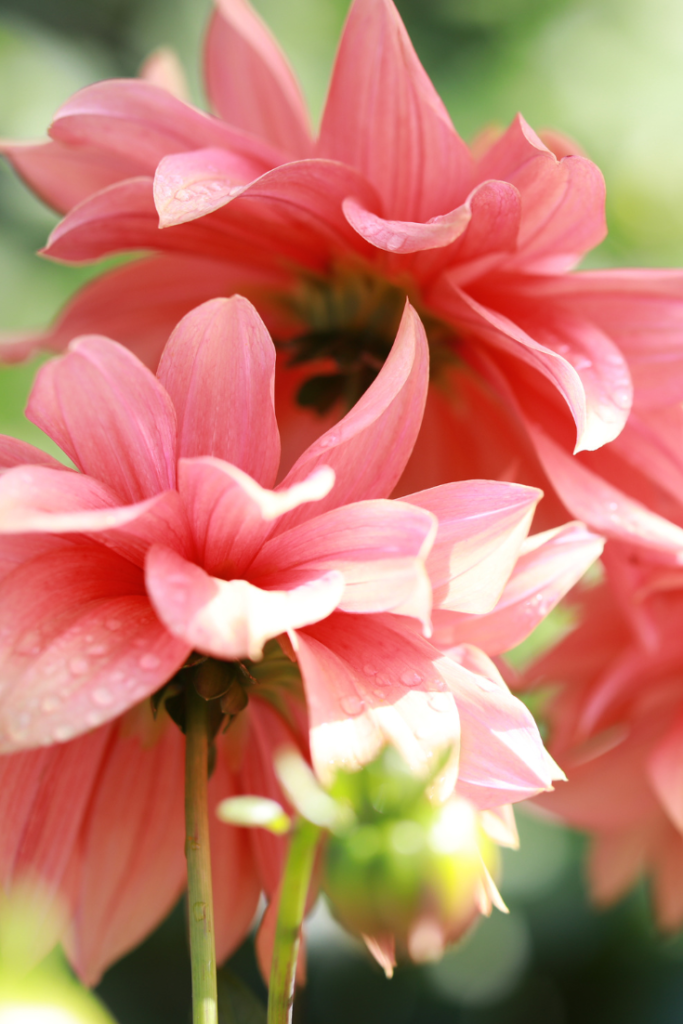
Hi friends! Whether you are new to dahlias or an enthusiast, I hope these dahlia resources prove helpful to you.
It Takes A Village
I’ve found that there is not just one right way to plant dahlias. There are so many farmers with so many techniques, and the secret is to do what you’ve found works for you. I’ve heard of planting depths all the way from 2 inches to a foot deep. I’d recommending following guides that have similar growing conditions to yours. Additionally, you can try different methods to see which one works best in your growing environment.
You can also reach out to the Dahlia Society and find out what’s customary in your state. They also have a wonderful guide with photos to help support you as you take care of your dahlias.
Floret also has a wonderful guide that may be helpful to you.
What we do on our micro-farm
Here are the steps that we follow for fabulous dahlias.
- Choose a site that gets at least 8 hours of sun.
- Prepare your location: make sure that the soil is soft and not compacted. You can use a broad fork to loosely (very loosely) jiggle in the soil to add little pockets of air. Add 2-4 inches of compost.
- STAKING: If you have a few plants and want to individually stake them, this is the time to do it: at planting. Adding a stake later in the process may pierce the tuber. Plant the stakes at the same time you plant the tubers to make sure they go into the ground, and not the body of the tuber.
- We plant our dahlias about 5 inches deep. Make sure every tuber is happy and healthy, offers a body, strong neck and a visibile eye. Throw in a sprinkle of bone meal into the hole. Plant the tuber on its side (this is important) about 5 inches down, with the eye up.
- Cover with soil.
- Plant dahlias 1 foot apart. (Floret recommends 12-18 inches apart but we can get away with closer ~ if you do so, once the plants are about 3 feet tall, be sure to remove foliage on the bottom 1-foot of the stem to help with air flow).
- WATERING: Do NOT water at all until sprouts emerge through the soil. Watering at this stage promotes rot. Once you see shoots come up, you can start watering, but not too much. I do 2 waterings a week and keep it to a medium amount. Also watch the weather patterns. There’s no need to water if it’s raining.
- Pests love dahlias, especially the young shoots. Offer bait at when the shoots appear. I add an organic compound named Sluggo which helps with slugs, snails and earwigs. I do a second sprinkle a few weeks later.
- PINCHING: When plants are about a foot tall (with 4 sets of leaves or so with a 4 inch shoot on top), give them a hard pinch of the 4 inch shoot. Simply snip off with some shears or use your fingers to pinch off the top. This promotes side shoots to grow which will make the dahlia bushier and have more blooms. Not doing this will keep your dahlia growing a thick middle stem, and it will grow quite tall with not so many flowers.
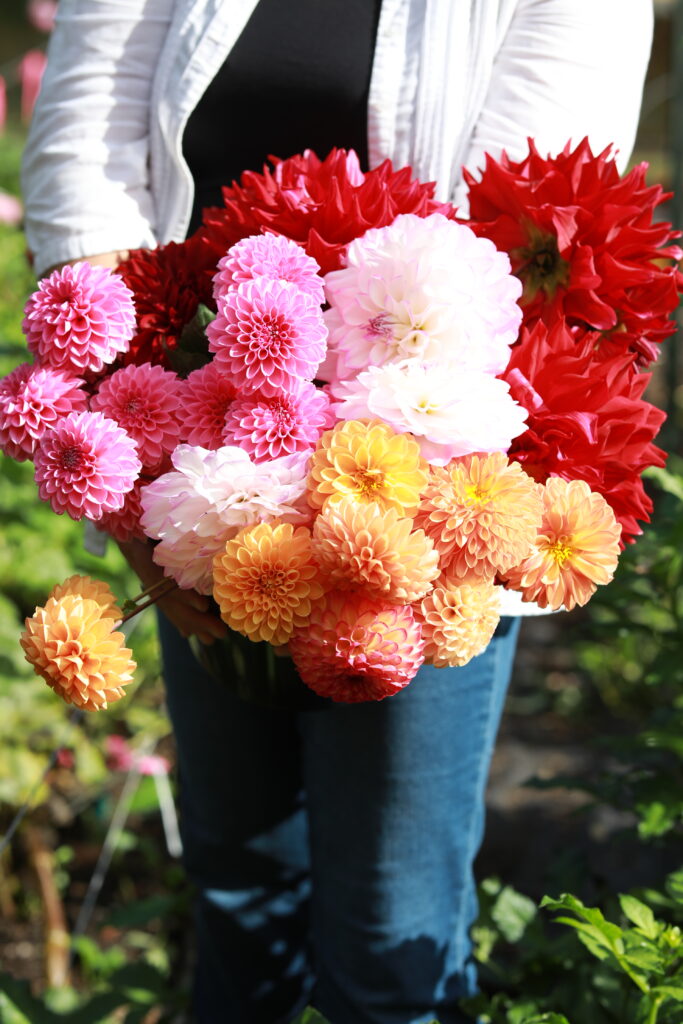
Guarding against pests
If you find that your dahlias are being nibbled on (by earwigs and other bugs), you can simply cover the buds before they open with organza bags. Bugs can get in and ravage the petals, which is not something you want to see after so many months of growing. Bugs especially like the whiter/lighter varieties.
Harvesting
Dahlias don’t open much more after you’ve cut them, so try to get them towards their mature stage where they’re mostly open.
When a dahlia has bloomed and you want to harvest, cut the dahlia deep in the plant (about the length of your elbow to your wrist) to promote a second flush of longer stems. Do this even if it means you cut some of the immature side buds. Those add beauty to arrangements and bouquets.
For larger blooms, you can also disbud some of the baby buds that are growing beside the main flower stem. We sometimes do this if there are many right next to the main flower, but if there’s just one flower stem with two babies on the side 5 inches down, we don’t disbud.
Look at the back of the dahlias to make sure that all the petals are healthy. If petals are starting to discolor or dry, it shows that the flower is older, which affects vase life.
Best harvesting time is the early morning before the sun is up, or later evening, since the flowers are most hydrated. The stems of dahlias are hollow, so they’re not the best drinkers. Once cut, get them into a bucket of hot water. Let that hot water cool in the bucket, and then arrange. Don’t walk around with them in your hand and take them inside later.
Expect 4-6 days of vase life, depending on the variety/type.
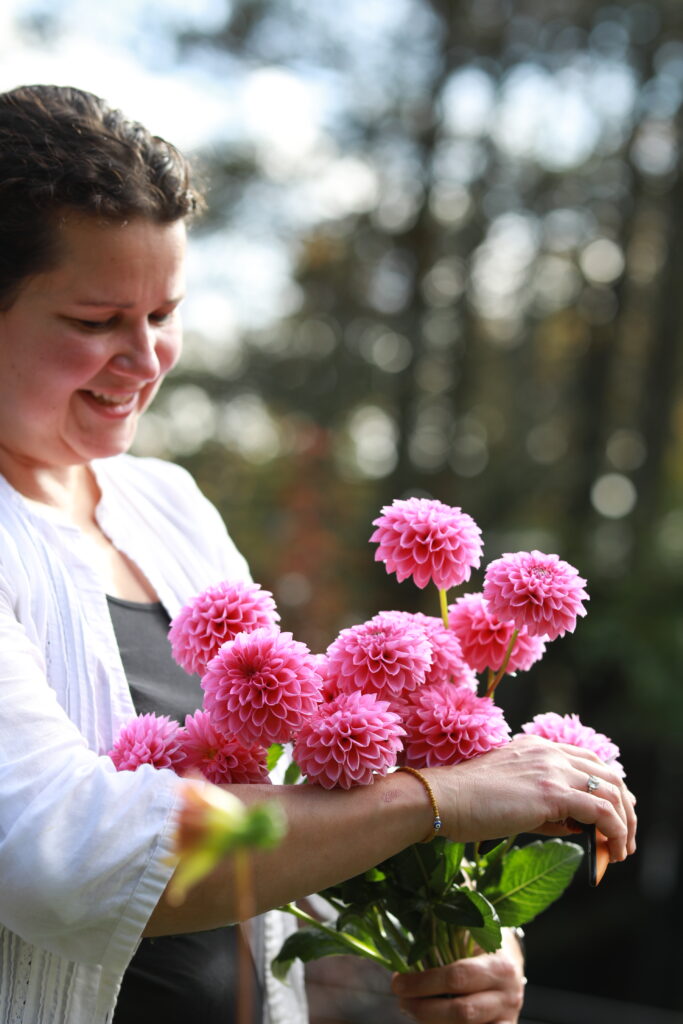
Overwintering
For the most part, I dig out my dahlias in the fall. I wait for a hard frost (a killing frost, not just a little dip in temps) that makes the dahlias go black. I then wait 2 weeks or so for the tubers to cure (much like a potato), cut the stem, and carefully dig out the dahlia clumps with a pitch fork. At this point, I wash the clumps, divide, dry, and store in vermiculite bins until the next spring.
If you choose to overwinter your dahlias (leave them in the ground), you may have some great success. We have had very mild winters here lately and even when I forget a dahlia or two in the ground, they mysteriously reappear the next spring. This is risky, though, as it’s not a fool-proof way to get your dahlias to come back. That said (and in New Jersey) if you get a hard frost, simply cut the stem back close to the ground, cover with a big pile of leaves, and let it be until the spring. Hopefully you will have some shoots coming back.
Please note that overwintering dahlias may also overwinter some of the pests associated with dahlias. But it’s still a worthwhile experiment if you’re not into digging or storing.
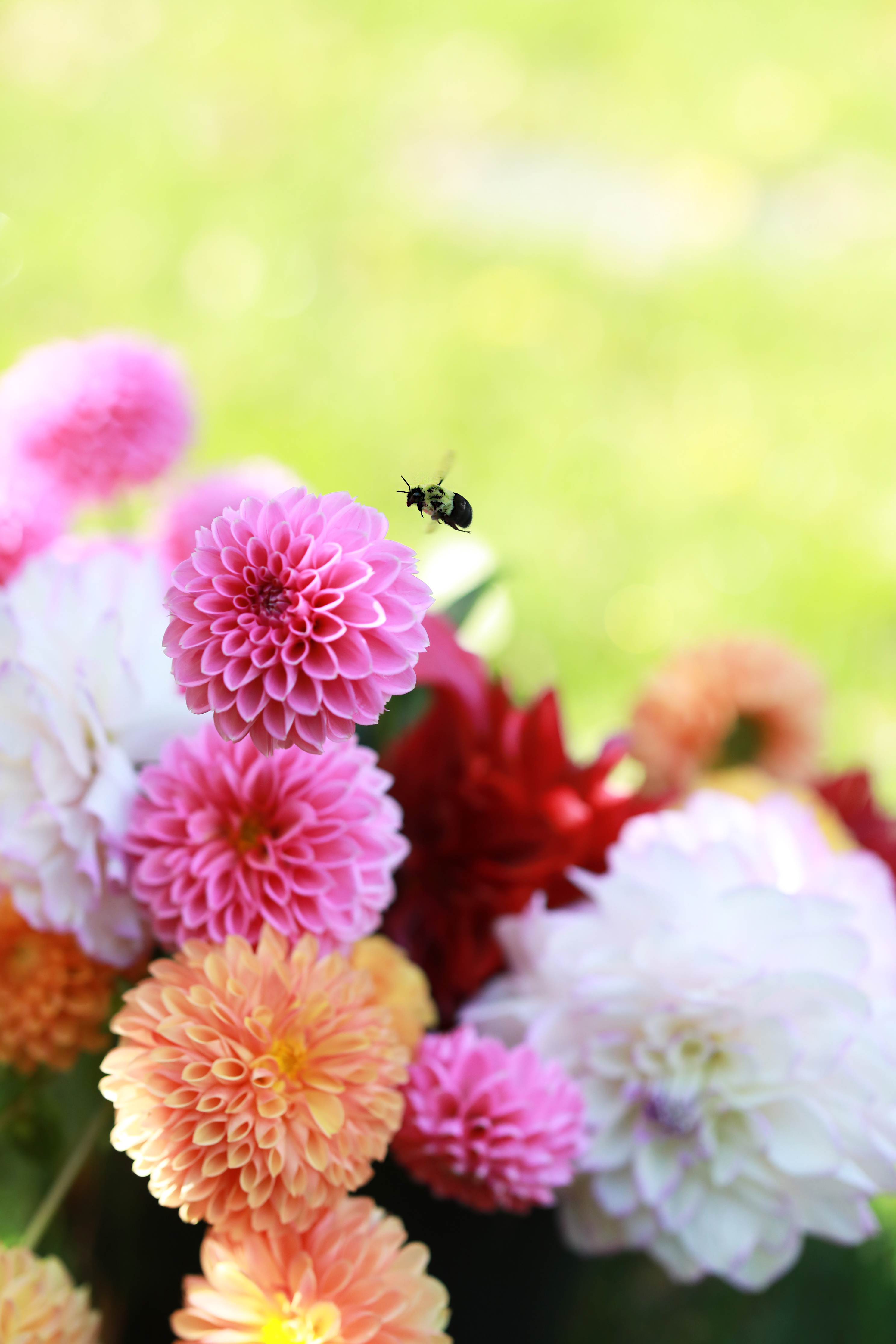
Books I love
These are some of the books that have really helped me on my journey.
Dahlias: Beautiful Varieties For Home and Garden
Floret’s Farm Discovering Dahlias
Floret Farm’s Cut Flower Garden
Dahlia Breeding for the Farmer Florist and the Home Gardener
Connie’s Dahlias, a Beginner’s Guide

Where to buy dahlias
Unfortunately, many dahlias come from overseas. Since their production is massive, they use machines to dig out the dahlias in clumps, and a lot of tubers get hurt and necks get broken. When they’re shipped to you, the often come damaged. Also, due to the high production without a lot of manual care, the incidence of disease is much greater.
I would recommend buying from small farmers in the US. I would check with them to see if they use organic practices, also, since it’s very common even from small farms to spray the dahlias with ingredients that stay in them for years to come and contaminate your soil. For instance, please follow our dahlia tuber page: www.LittleBloomsOfJoy.com
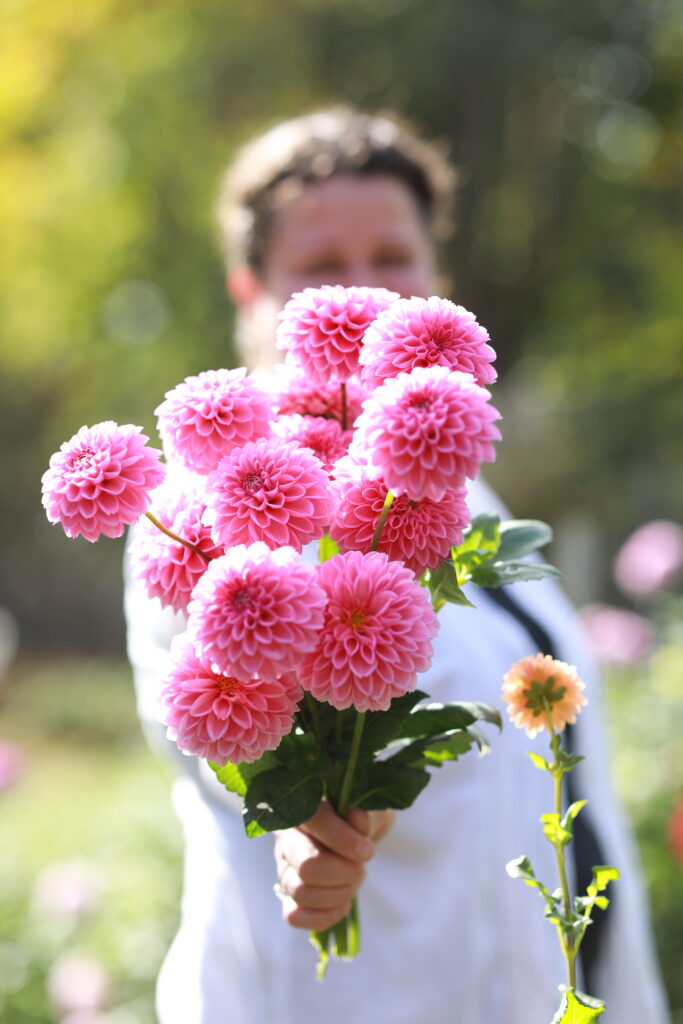
Dahlia FB group
There is a lovely growers group on Facebook, and I’ve made some beautiful new friendships because of it! Check it out here.

Love Gardening Info?
View all of our gardening articles!
and more….
Interested in our CSAs? Check out our shop here: SHOP
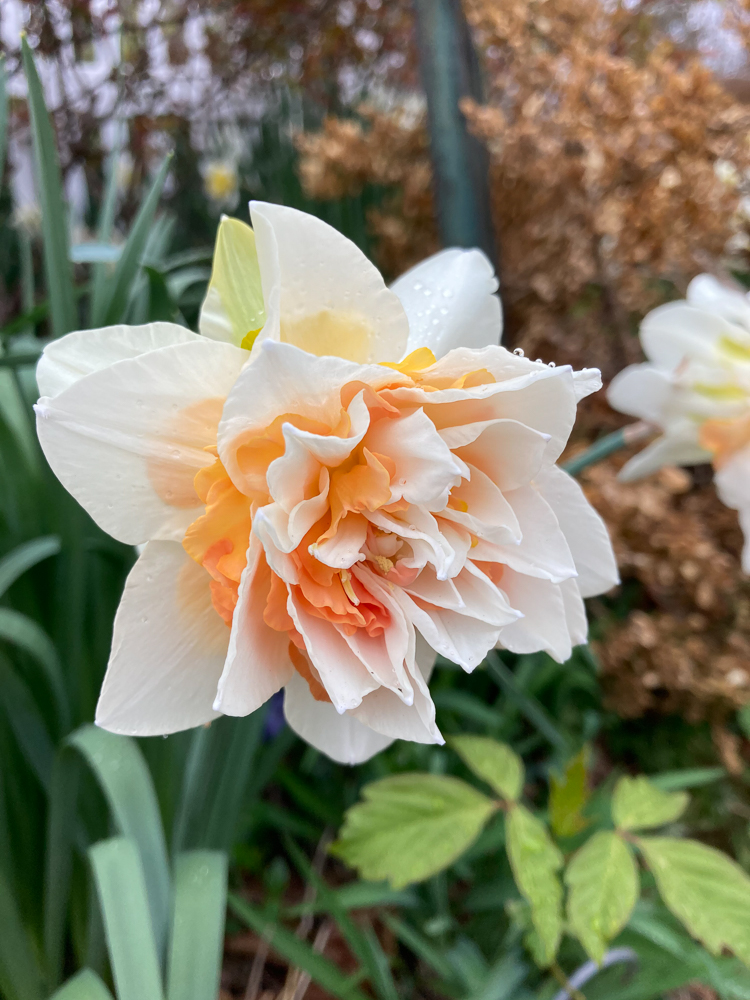



Reach out!
If you have any questions, I’m happy to help. Email me at dreea@littlebitesofjoy.com and let’s keep the conversation going!

Leave a Reply